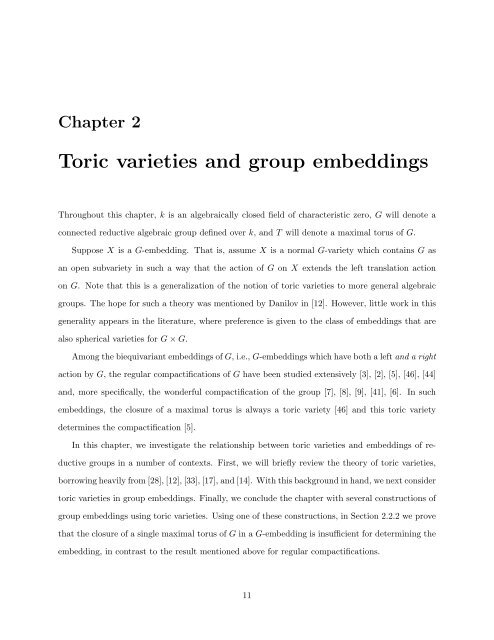Equivariant Embeddings of Algebraic Groups
Equivariant Embeddings of Algebraic Groups
Equivariant Embeddings of Algebraic Groups
You also want an ePaper? Increase the reach of your titles
YUMPU automatically turns print PDFs into web optimized ePapers that Google loves.
Chapter 2<br />
Toric varieties and group embeddings<br />
Throughout this chapter, k is an algebraically closed field <strong>of</strong> characteristic zero, G will denote a<br />
connected reductive algebraic group defined over k, and T will denote a maximal torus <strong>of</strong> G.<br />
Suppose X is a G-embedding. That is, assume X is a normal G-variety which contains G as<br />
an open subvariety in such a way that the action <strong>of</strong> G on X extends the left translation action<br />
on G. Note that this is a generalization <strong>of</strong> the notion <strong>of</strong> toric varieties to more general algebraic<br />
groups. The hope for such a theory was mentioned by Danilov in [12]. However, little work in this<br />
generality appears in the literature, where preference is given to the class <strong>of</strong> embeddings that are<br />
also spherical varieties for G × G.<br />
Among the biequivariant embeddings <strong>of</strong> G, i.e., G-embeddings which have both a left and a right<br />
action by G, the regular compactifications <strong>of</strong> G have been studied extensively [3], [2], [5], [46], [44]<br />
and, more specifically, the wonderful compactification <strong>of</strong> the group [7], [8], [9], [41], [6]. In such<br />
embeddings, the closure <strong>of</strong> a maximal torus is always a toric variety [46] and this toric variety<br />
determines the compactification [5].<br />
In this chapter, we investigate the relationship between toric varieties and embeddings <strong>of</strong> reductive<br />
groups in a number <strong>of</strong> contexts. First, we will briefly review the theory <strong>of</strong> toric varieties,<br />
borrowing heavily from [28], [12], [33], [17], and [14]. With this background in hand, we next consider<br />
toric varieties in group embeddings. Finally, we conclude the chapter with several constructions <strong>of</strong><br />
group embeddings using toric varieties. Using one <strong>of</strong> these constructions, in Section 2.2.2 we prove<br />
that the closure <strong>of</strong> a single maximal torus <strong>of</strong> G in a G-embedding is insufficient for determining the<br />
embedding, in contrast to the result mentioned above for regular compactifications.<br />
11
















